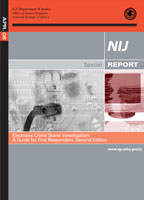Are you having trouble viewing this email? View it online here: www.crime-scene-investigator.net/newsletter/0215.html This message
was not sent unsolicited. You signed up for this newsletter. If you wish to unsubscribe see the instructions at the bottom of this message.
|
|
||
|
FEBRUARY 2015 | ||
|
Welcome to the February 2015 Crime Scene Investigator Network Newsletter
| ||
|
This Month's Featured Resource on the Crime Scene Investigator Network Website
|
||
 This guide is intended to assist State and local law enforcement and other first responders who may be responsible for preserving an electronic crime scene and for recognizing, collecting, and safeguarding digital evidence. It is not all inclusive but addresses situations encountered with electronic crime scenes and digital evidence. All crime scenes are unique and the judgment of the first responder, agency protocols, and prevailing technology should all be considered when implementing the information in this guide. First responders to electronic crime scenes should adjust their practices as circumstances—including level of experience, conditions, and available equipment—warrant. |
||
|
Featured Video Presentation
|
||
|
Learn the basic technique for processing latent fingerprints by dusting with black powder. |
||
|
New CSI and Forensic Job Announcements
|
||
|
The most comprehensive listing of Crime Scene Investigation and Forensic To be notified of job openings as they are posted, follow us on Twitter: Job Posting Alerts |
||
|
Forensic Specialist (CSI)
Culver City Police Department, California, USA Final Filing Date: February 16, 2015 Salary: $5,475 to $6,683 Monthly This non-sworn position is responsible for performing a variety of tasks and procedures relating to crime scene investigation, documentation, analysis, and storing of physical evidence for investigative and law enforcement purposes. ... <View complete job listing> |
||
|
Crime Lab Analyst — Digital Evidence
Florida Department of Law Enforcement, Tallahassee, Tampa, Florida, USA Final Filing Date: June 30, 2015 Salary: $40,948.18 - $75,649.72 per year Analysts in the Digital Evidence section conduct detailed laboratory examination and analysis of computer evidence involved in criminal cases at the request of law enforcement agencies. ... <View complete job listing> |
||
|
Forensic Chemist I/II (DNA)
Prince George's County Police, Landover, Maryland, USA Final Filing Date: February 24, 2015 Salary: $43,968.00 - $88,384.00 Annually Conducts serologic analyses on physical evidence to identify body fluids; performs DNA analyses on serologic evidence according to established protocols; ... <View complete job listing> |
||
 |
||
|
Property and Evidence Technician
Fresno Police Department, California, USA Final Filing Date: February 17, 2015 Salary: $3,205 - $3,872 Monthly Receive, store, and dispose of property and evidence held by the Police Department, safeguard inventories, maintain chain-of-evidence records and may be called upon to testify in court. <View complete job listing> |
||
|
Forensic Scientist 2 — Latent Fingerprints Analyst
New Mexico Department of Public Safety, Santa Fe, New Mexico, USA Final Filing Date: February 19, 2015 Salary: $21.53 - $37.46 Hourly As a Forensic Scientist 2, the incumbent will perform analysis of latent print evidence; the incumbent will be responsible for independently collecting, classifying, identifying and analyzing latent fingerprint evidence related to criminal investigations. ... <View complete job listing> |
||
|
Hi-Tech Crime Investigator
British Transport Police, Camden, UK Final Filing Date: 18 February 2015 Salary: £36,516.11 per annum Carry out computer crime investigations and forensic data recovery, support investigations and the subsequent forensic handling of digital data and evidence including the imaging of computer material. ... <View complete job listing> |
||
|
Search for more job listings in Crime Scene Investigations and Forensics To be notified of job openings as they are posted, follow us on Twitter: Job Posting Alerts |
||
|
CSI in the News
|
||
|
£6m investment boosts DNA profiling Fingerprint Examiners Found to Have Very Low Error Rates Next-Gen Sequencing Maps 'Highly Degraded' DNA NIST Forensic Science Standards Committees to Hold First Public Meetings in February 2015 Reston company develops new forensic DNA analysis technique |
||
|
Other Resources on the Crime Scene Investigator Network Website
|
||
|
Not Subscribed to this Newsletter?
|
||
|
If you are not subscribed to this newsletter, you may subscribe with this link: SUBSCRIBE via email |
||
|
To Unsubscribe
|
||
|
To unsubscribe from future e-mail newsletters, please click here: UNSUBSCRIBE Copyright ©2015 Crime Scene Resources, Inc. Crime Scene Investigator Network |



